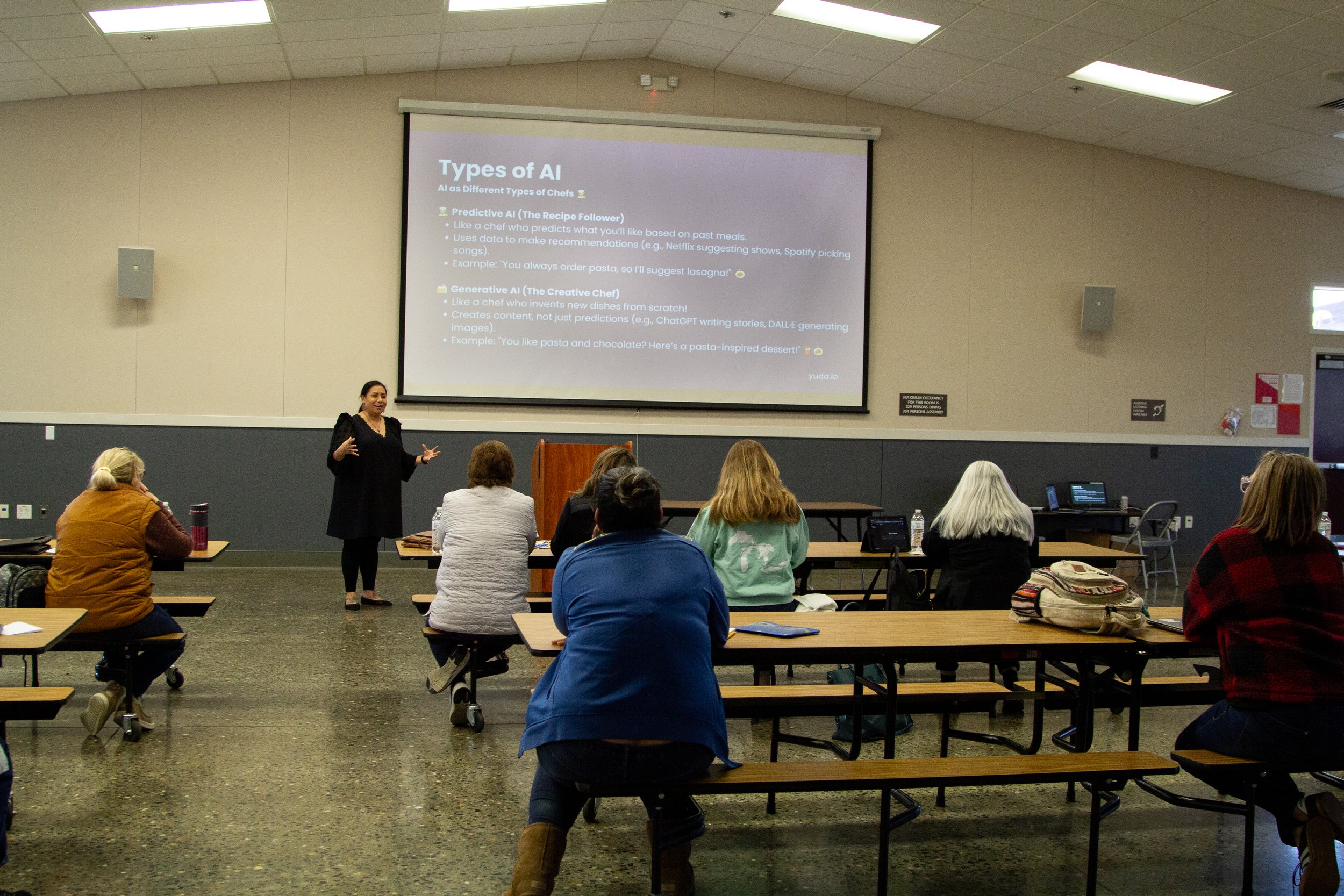
AI Made Simple. Continuing Your Journey.
AI Made Simple
AI Made Simple is an engaging, community-focused workshop series designed by yüda in partnership with Ceres Adult School. Launched in March 2025, this program introduces parents and community members with little or no technical background to the fundamentals of Artificial Intelligence (AI). Each session is crafted to be accessible, interactive, and culturally relevant, empowering participants to recognize how AI shapes their daily lives and communities. Through practical examples, hands-on activities, and clear, jargon-free teaching, AI Made Simple aims to demystify technology, foster digital confidence, and inspire continued learning.
Program Topics
The History of AI
Real World Examples of AI
Types of AI
Human Learning vs Machine Learning
AI is Powerful, But Not Perfect
Intro to Prompt Engineering
Advanced Prompt Engineering: Frameworks
Advanced AI Tools
AI Ethics
The Future of AI
Creating Your First Chatbot
Resources
-
Reach out to us at: info@yuda.io
-
Need a Coursera scholarship? We got you covered, sign up here.
-
-
MIT Technology Review Newsletter – Weekly updates on emerging technologies.
AI Weekly (VentureBeat)– Latest developments simplified for easy reading.
Empowered by AI
Understanding AI empowers you, not just to navigate technology confidently, but to shape the future by thinking critically and making informed decisions about every innovation ahead.
AI Vocabulary Cheat Sheet
Artificial Intelligence (AI)
A technology that allows computers to perform tasks typically requiring human intelligence, such as recognizing speech, images, or making decisions.
Machine Learning (ML)
A method within AI where computers learn from data and improve without being explicitly programmed for every task.
Example: Email spam filters getting better at detecting unwanted messages.
Algorithm
A clear set of rules or instructions that a computer follows to solve a problem or complete a task.
Example: Steps a GPS app uses to find the quickest route.
Data
Information used by computers to learn and make decisions.
Example: Photos used by a social media platform to identify faces.
Bias
Unfair prejudice in data or algorithms that leads to inaccurate or unfair results.
Example: A hiring AI system unfairly favoring certain groups because of biased training data.
Neural Network
A type of AI modeled loosely on the human brain, helping computers recognize patterns.
Example: AI systems recognizing objects or people in pictures.
Chatbot
A computer program that simulates conversations with people using AI.
Example: Customer service assistants answering questions online.
Natural Language Processing (NLP)
An area of AI focused on helping computers understand and respond to human language.
Example: Voice assistants like Siri or Alexa.
Ethics in AI
Considering the moral implications and responsibilities of creating and using AI technologies.
Example: Deciding how AI should be used in healthcare or job hiring to ensure fairness and privacy.
Automation
Using technology to perform tasks automatically without constant human oversight.
Example: Auto-completing text in emails or messages.
Deep Learning
A type of machine learning using complex neural networks to deeply analyze data and recognize intricate patterns.
Example: Facial recognition technologies or self-driving cars.
Training Data
The initial data used to teach an AI system how to perform a task.
Example: Images of cats and dogs used to train AI to recognize pets.
Beginner's Guide to Prompt Engineering
Prompt engineering is the skill of designing clear and effective prompts to communicate with AI chatbots (like ChatGPT or Gemini). Good prompts help you get accurate and useful responses.
-
Description ART helps structure prompts clearly:
A - Action: Tell the AI exactly what action you want it to perform.
R - Role: Give the AI a specific role or perspective to reply from.
T - Task: Define the specific task or output clearly.
Example:
“Act as a professional chef (Role) and explain clearly (Action) how to make pancakes step-by-step (Task).”text goes here
-
CREATE helps ensure detailed and complete responses:
C - Clear: Provide clear instructions.
R - Role-based: Specify the role of the AI.
E - Explicit: Clearly state expectations.
A - Action-oriented: Indicate what specific action the AI should take.
T - Targeted: Define the audience or goal clearly.
E - Engaging: Request engaging or interactive responses if appropriate.
Example:
“You're an enthusiastic history teacher (Role-based). Provide a clear and engaging summary (Action-oriented, Engaging) of the American Revolution for middle school students (Targeted). Use simple language and highlight key events (Clear, Explicit).”
-
TAG helps in creating short, direct, yet effective prompts:
T - Task: Specify the task clearly.
A - Audience: Mention who the response is intended for.
G - Goal: Clearly define the goal or objective of the response.
Example:
“Explain climate change (Task) to a 10-year-old child (Audience) so they understand why it matters (Goal).”
-
IDEAL helps structure prompts aimed at solving problems clearly:
I - Identify: Clearly identify the problem or issue.
D - Define: Define the constraints or requirements for solving the problem.
E - Explore: Ask the AI to explore possible solutions or options.
A - Assess: Request an assessment of the solutions provided.
L - List: Clearly instruct the AI to list the recommended solution steps.
Example:
“Identify ways to reduce household energy use (Identify). Define that solutions must be affordable and practical (Define). Explore different options (Explore) and assess their effectiveness (Assess). Provide a clear list of recommended actions (List).”


